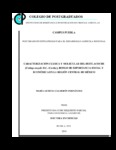| dc.description.abstract | Las secuencias de ADNr han sido útiles para clasificar a muchos basidiomicetos, debido a que se pueden caracterizar en muchos niveles taxonómicos en base a sus regiones conservadas y variables. Tal es el caso de los Ustilaginales, los cuales tienen importancia por sus implicaciones económicas adversas, por lo que han sido estudiados mediante algunas de estas técnicas, especialmente con la región ITS del ADNr, ya que muestran diferencias a nivel de nucleótidos, permitiendo establecer la diversidad genética de hongos a nivel inter e intra-específico. En este contexto se tiene a Ustilago maydis, el cual es un hongo que infecta al maíz produciendo el “huitlacoche” o “carbón del maíz” del cual existen estudios limitados sobre su características morfológicas y genéticas. Por lo que en esta investigación se realizó un estudio sobre la caracterización de más de 100 especímenes de huitlacoche y las cepas aisladas de éstas, obtenidas de 42 zonas geográficas de nueve estados de México (Chiapas, Guanajuato, Hidalgo, México, Morelos, Puebla, Querétaro, Tlaxcala, y Veracruz). Se determinó que existe correlación entre el origen con el índice de severidad y con la variedad de maíz, siendo los maíces blancos los más susceptibles. También se encontró correlación entre el color de las agallas con su textura y con su tamaño, ya que al ser más obscuras, son más blandas y grandes. Así mismo, se determinó la diversidad genética de 36 cepas mediante la región ITS del ADNr, encontrando que existe una significativa diversidad genética entre ellas (4.3%) por análisis de máxima parsimonia, lo que puede deberse a la existencia de poblaciones pertenecientes a subespecies, razas o biotipos de U. maydis. _______________ CLASSICAL AND MOLECULAR CHARACTERIZATION OF “HUITLACOCHE”
[Ustilago maydis D.C. (Corda)], A FUNGUS OF SOCIAL AND ECONOMIC IMPORTANCE IN THE CENTRAL REGION OF MEXICO. ABSTRACT: rDNA sequences have been useful to classify many Basidiomycetes, because they can be analysed on the basis of their conserved and variable regions. This is the case of Ustilaginales, which have negative economic impact on agriculture, and their inter- and intra-specific genetic diversity has been assessed through the nucleotide differences at the ITS region of the rDNA. In this context, Ustilago maydis is a fungus that infects corn producing the "huitlacoche" or corn smut, and there are limited studies on its morphological and genetic characteristics. In this research, more than 100 specimens and strains of "huitlacoche", obtained from 42 geographical areas of nine States of Mexico (Chiapas, Guanajuato, Hidalgo, México, Morelos, Puebla, Querétaro, Tlaxcala, and Veracruz), were characterized on the basis of morphology. A correlation was found between the origin and the rate of severity, as well as the variety of corn, white corn being the most susceptible. We also found a correlation between the color of the galls and its texture and size, darker galls are softer and bigger. A significant genetic diversity (4.3%) was found in 36 strains of U. maydis using the ITS region of the rDNA, through maximum parsimony analysis, suggesting the existence of populations belonging to subspecies, races or biotypes. | es |

